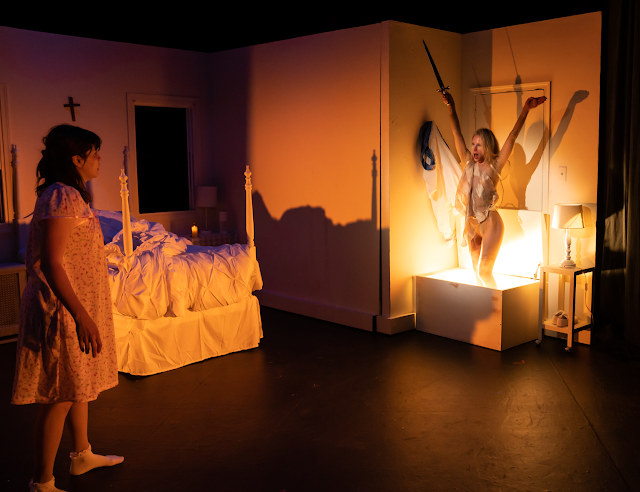Candlelight
Written by John Patrick Shanley
Directed by Lori Kee
154 Christopher St., Manhattan, NYC
November 27-December 19, 2021
 |
| Ivette Dumeng And Christina Toth. Photo by Al Foote III |
Candlelight, from which the new play by Pulitzer Prize winner and Bronx native John Patrick Shanley takes its name, can create a flickering, twilight liminality, and, indeed, dreams, reality, and imagination bleed fluidly into one another in this world-premiere production at the New Ohio Theatre. Such illumination also, in Candlelight, is associated with love, which in the play is, if not many-splendored, then certainly multifarious—transformative love; parental love; lost love; unrequited love; dangerous love; a link, or in some cases a tether, to the past and a hope, however well-founded, for the future. Centering the perspectives of two ten-year-old Nuyoricans from Brooklyn, Candlelight entangles whimsy with melancholy, hilarity with heartache, and wonder with pain. |
| Marc Reign and John Cencio Burgos. Photo by Al Foote III |
We meet Esperanza (Ivette Dumeng) at her tenth birthday party, where she shares a dance with fellow ten-year-old Tito (Marc Reign). Afterwards, in her all-white bedroom, she talks to her fairy doll and playacts grandly for a bit before her father, Hector (Alfredo Diaz) comes to put her to bed, Esperanza uttering, before he says good night, the short but ominous phrase "Don't drink."
Candlelight becomes Tito's story as well. He invites lonely outcast Paulie (John Cencio Burgos), himself looking for love and inclusion, to his apartment to talk about Esperanza, entangling Paulie inevitably in what evolves. Esperanza and Tito are companions not only in the liminal tween years but also, for example, in the mirroring of their parental situations, and Tito reflects Esperanza's nagging awareness of reality increasingly intruding into her world of magic in his own desire to escape reality altogether. For good and ill, the waking and dreaming worlds of this pair begin to merge.
 |
| Darlene Tejeiro. Photo by Al Foote III |
Esperanza's and Tito's ways of seeing and processing the world lead to a number of surprising, visually inventive moments, most of which are humorous but a couple of which qualify as authentically creepy. The younger characters themselves display a mix of fear, self-confidence, and yearning characteristic of their ages and shaped by their circumstances, and the performers both endearingly and comedically convey without overplaying the trio's youth. Dumeng is excellent as the play's earnest, sad, brave, magical realist center, while Burgos and Reign are extremely funny together (the former also makes an excellent talking mirror), but also bring a tenderness to Paulie and Tito's spikier interactions. Diaz similarly is very funny (as Esperanza's fantasy alter ego for her father) except when he is frightening (as the actual Hector). Darlene Tejeiro, enjoyably silly as another talking object, lends a solemn weight to the appearances of Esperanza's mother, and Christina Toth's Mabel the fairy is simultaneously graceful and gruff.
The final image of the play returns us to its beginning—through dance, an important, recurring mode of expression and relationship in a production with some infectious musical selections and choreography—but overlaid with the poignancy of what has transpired in between. Candlelight includes at least one thread of significant intertextuality, but it is very much its own animal, one whose playfulness might make you forget, for a time, about its claws.
-John R. Ziegler and Leah Richards






Comments
Post a Comment